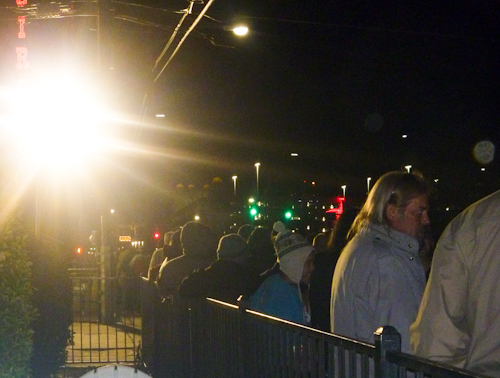by Jessica Reeder and Natalie Minor
When the United States economy crashed in 2008, it brought many Renoites down with it. In 2010, one in 16 homes went into foreclosure, and unemployment has hovered around 12 percent since the recession hit. While the rest of the nation has begun to recover from the crash, Reno is expected to remain economically depressed until 2021 – an unbearably long time for families who have nowhere else to go. As a result, homeless residents have established a Tent City near the downtown community shelter, where an untold number live in tents and lean-tos nearby. With so many living on the streets or in homes they can barely afford, food is often not a budgetary item—and even less affordable is a holiday feast with family. Of the 315,000 Reno/Sparks citizens, tens of thousands seek community help to fill their empty stomachs.
But this community staunchly refuses to let anybody go hungry during the holidays. The Food Bank of Northern Nevada, churches, schools, supermarkets and restaurants – everyone chips in, and everyone eats. Evelyn Mount and her Community Outreach group collected enough donated food to deliver to 11,000 folks for Thanksgiving, and more will be fed for Christmas. Free community dinners were offered for Thanksgiving by Catholic Charities and the Nugget, the Boys and Girls Club and Bully’s Sports Bar, and the Salvation Army and Harrah’s. Over 10,000 mouths were fed through community dinners this year, and the numbers in need are rising. St. Theresa Church and Yerington High School host annual community Christmas dinners. Verdi Mining Company will serve a Christmas feast as well. If you’re hungry in Reno during the holidays, you can get turkey, potatoes and a stocking full of goodies – no questions asked.
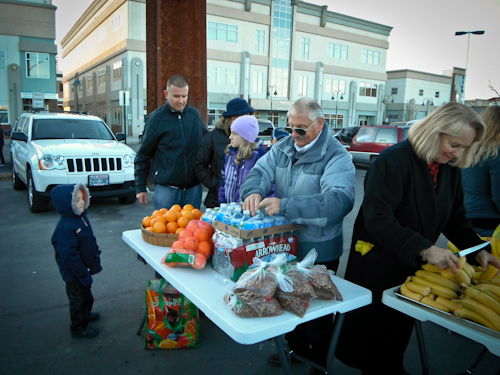
Volunteers for Loving Hearts Club serve a meal every Sunday night in downtown Reno. Photo by Natalie Minor.
VOLUNTEERS MAKE COMMUNITY WORK
When the holiday season is over, though, the turkeys and stockings disappear along with most of the volunteers. The need decreases slightly, but not much. For the otherremaining ten months of the year, Reno’s hungry congregate behind the Reno Aces Ball Park, where a few dedicated groups work together to provide hot dinners every night of the week.
Amber Dobson of We Care Volunteers is up at 4am chopping vegetables, Monday through Thursday. Each evening, she coordinates a hot, nutritious dinner at the Gospel Mission, rain or shine. “It doesn't matter who they are or whether they have a home,” she says. “If they're hungry, they can come down and get a hot meal.”
The Loving Hearts Club is also one of the strongest efforts in Reno to feed the hungry. This group, formed by Karmen Robbins and Billy Woods, serves hundreds of homeless and poor individuals on Sundays off 4th Street. “I liked the concept of people helping other people,” Robbins says. “We started with five people offering peanut butter and jelly sandwiches and one little bench,” she says. Now, the Club has 18 tables and hundreds of community members to serve meals every week. “People just bring food and share,” Robbins says.
The Reno Initiative for Shelter and Equality (RISE) is a newcomer to the scene, a loose group of activists born from Occupy Reno. In early 2012, RISE started hosting Saturday night community dinners at Tent City.
Into that sharing pot, toss the LoKa Tile Group, a member of Reno’s Conscious Community that organizes volunteers to serve Friday dinners at the shelter. LoKa accepts food, clothing and monetary donations through its website.
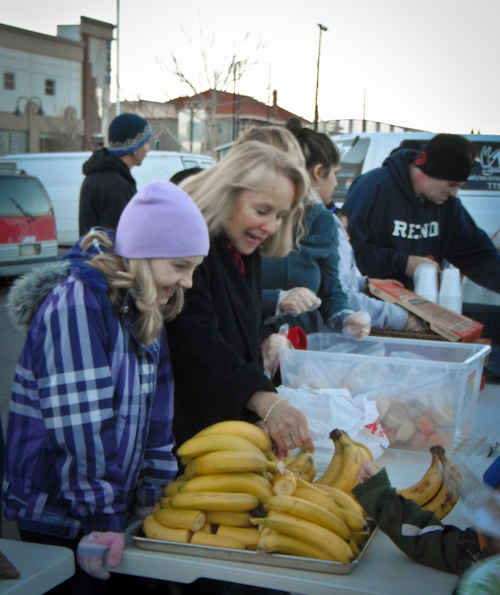
Sundays are the biggest turn-out days at the Record Street parking lot, with up to 400 people arriving to enjoy a hot meal and helping hands. Volunteers show up with trays of food they cook in their own kitchens and clothes, blankets, and sleeping bags for warmth. While the volunteers set up, the less-fortunate arrive at a gate that spills out to the grassy area next to the parking lot. The security officer gives out about 120 tickets to keep the line organized, but the need far surpasses the slips of paper—and too often, the food.
Once everyone is in line, volunteers open their Tupperware, foil covers and pot lids to expose hot soup, baked pasta, casseroles and salads. Other food items can be pallets of bread or water bottles, boxes of bananas, baskets of oranges, or a hot drink. Donations of shirts and pants, hats and gloves, coats and sweaters are an additional treat at the end of the food tables. Basic hygiene items like a toothbrush and comb might even be stuffed into a pair of socks. Volunteers give until they are out of supplies, and then pack up. Everyone helps clean and fold the tables down, re-pack unused plates and plasticware, and carry the trash to the dumpster.
CONNECTING MEMBERS OF THE COMMUNITY
In a population so brutally hit by the economic crash, it’s difficult to imagine how – or even why – people who are barely hanging on to their homes and jobs can possibly help those who have lost everything. In speaking with the individuals who run these charitable groups, one thing became very clear: the line crossed from serving to being served is a very vague one, if it exists at all—and one that sees a good amount of back-and-forth.
Reno is uncommon in this aspect, as compared to many cities where need is great, but help is scarce. Most people who feel compelled to give in this community have had their own bouts with poverty and even homelessness. And, when they’re able to give back, they do.
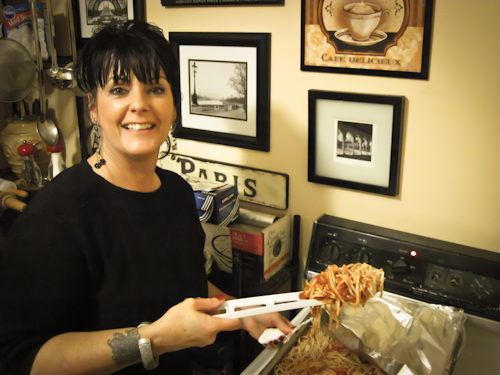
Amber Dobson prepares to serve a spaghetti dinner for hundreds out of her small kitchen. Photo by Jessica Reeder.
Amber Dobson was new to town and unemployed in 2010, when she started volunteering with a local pastor who was taking peanut butter sandwiches to the Tent City residents. “It had just snowed,” she remembers, “and people were trying to get dry. They were so happy for a cup of noodles and a sandwich. I thought to myself, ‘there's got to be a better way of doing this.’”
Billy Woods also knows hunger. “I’ve been close to being homeless. But mainly, I’ve been hungry. I remember eating toothpaste in a hotel when there was nothing else to eat,” he says.
Karmen Robbins feels empathy toward those in need. “I was homeless 10 years ago with a baby,” Robbins says. “I hate to see people suffer. It doesn’t matter how you got there,” she says, “Everyone should have a balanced meal.”
Evelyn Mount agrees. Raised to believe that everybody should share whenever they can, she’s been running a nonprofit for 33 years out of her modest, brightly painted living room. “There will never be a time when people are not in need,” she says. “Only God can put it in the hearts of the people to fix it so there won’t be that need.”
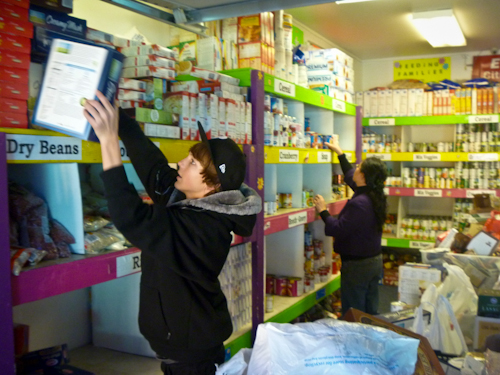
Brandon Davis and Imelda Loe volunteer for Evelyn Mount's Community Outreach organization, sorting food in the pantry. Photo by Jessica Reeder.
FOOD DRIVES HELP THE HUNGRY SURVIVE
Even with these groups doing all they can, the need for more food exists—especially at the end of the month. “You always know you'll need more food at the end of the month than at the beginning,” Dobson explains. SNAP benefits haven't been adjusted in years, and now will only buy enough food to feed a family for three weeks of every month. That last weeks’ worth of food has to be found elsewhere.
Tent City witnesses a flux of hungry mouths the last two weeks of the month. Cody Clanton has worked the Sunday 10am to 6pm security shift for a year, and says, “They know the good treats come at the beginning of the month. By the second week, word gets out.” Along with word getting out, “when food stamps run out, people who don’t have enough food in their homes come here for a meal,” Clanton says.
Many people also go across the street to the Catholic Charities dining hall, which offers dinner every night. On an average night, the dining hall serves 600 to 800 – always more at the end of the month than at the beginning. The Food Bank of Northern Nevada coordinates drop-offs around town, including providing a steady stream of non-perishables to Catholic Charities’ pantry. It all gets delivered to those who can prove their low income, including those who live on the street
“Lots of times, there’ll be dry beans or something in the box. Well, you can’t cook beans if you’re sleeping on the street. So they bring it to me, and I save it up, and eventually I serve it for dinner,” Amber Dobson says.
There’s never a single bean to spare; each of these groups has to pinch pennies, and contributes their own income to keep the food flowing. But the food flows, despite the rise in need. How do these groups find the funds to keep doing their work? The answer lies in community outreach and support.
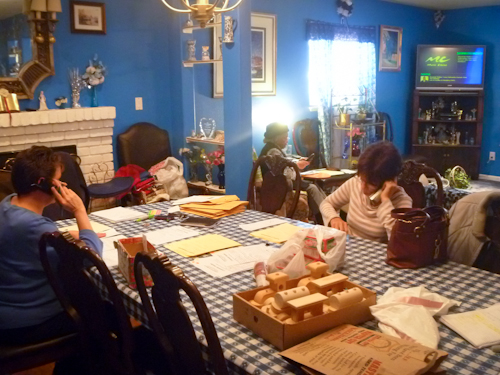
Evelyn Mount (in the background) runs Community Outreach out of her Reno living room. Photo by Jessica Reeder.
COMMUNITY RESOURCES PROVIDE A SAFETY NET
At first, RISE organizers were paying for 250 meals a week out of their own pockets. Then organizer Lauren Castro had an idea: Why not post on Craigslist about the need for food? It worked: people from all walks of life showed up with casseroles. “We're getting to the point where all we have to do is show up with tables, plates and forks, and people show up with food,” says organizer Ben Castro. “Whoever brings food, that’s what there is.”
Loving Hearts has also tapped community resources. Local chefs and restaurant owners have become frequent donors. Such notable participants are Charlie and Karen Abowd of Adele’s Restaurant and Lounge in Carson City. Executive Chefs Dan Shirley of Gourmet to Go Catering and Clint Jolly of Great Thyme Catering in Reno have also been known to make appearances. “Sometimes these people are served a gourmet meal by the best chefs around,” Robbins says. Other vendors donate plates, napkins, and plasticware. Loving Hearts also has a donated trailer to haul these goods and their tables, courtesy of a local pastor and volunteer.
Evelyn Mount and Catholic Charities have the biggest name recognition of all these groups, built up through decades of giving. Both do much of their outreach through the network of church communities in the area, which coordinate some of the biggest donations and volunteer efforts. But as Ben Castro notes, community dinners are a highly non-denominational affair. In fact, many people find that volunteering gives them the chance to meet people they wouldn’t otherwise. “You’ve got everybody from atheists to Buddhists, even LDS down there helping,” Castro says. “It brings you all together.”

Volunteers from Harrah's casino serve Thanksgiving dinner for over a thousand. Photo by Jessica Reeder.
Reno is so close a town that the degrees of separation between a homeless or hungry person are not many. Because of this, teams of inspired individuals, whose wish is to ease their suffering one day at a time, have cropped up and held the community together. And these individuals inspire others to volunteer, donate, and serve. Like any business or social network, connected members of society continue this sharing to hold up its citizens.
Offering food is one of the most heartfelt ways to share, and Reno just may have the biggest little heart in the world. People who have not much to give, but do anyway, are what makes this community continue to pulse. When volunteering to share, you know that a spoonful of the soup you served helped someone survive another day. Or that coat you watched someone pick from the pile of donations will keep him warm another night. “There is instant gratification in giving in person,” Robbins says. And that’s what it’s all about—people sharing with people.
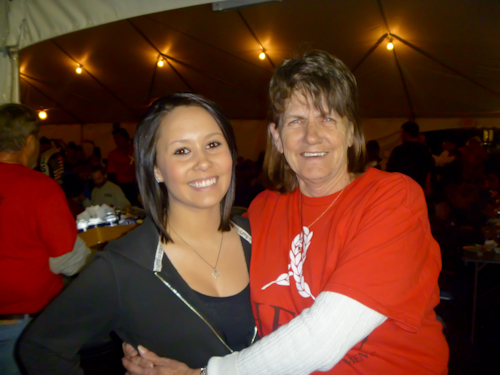
Janet Lies (right) heads up the Harrah's community service program and organizes dinners for thousands. Her granddaughter Brittani (left) has been serving at holiday dinners since she was six.
